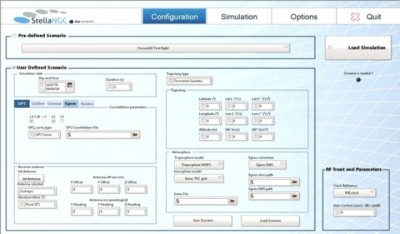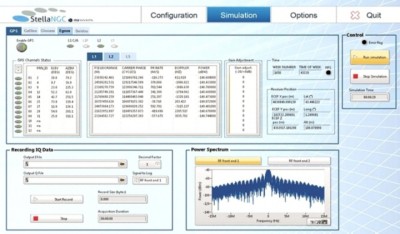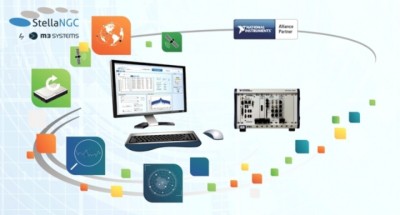Building a Satellite Navigation Test Platform Using the NI Vector Signal Transceiver
David Bourdier, M3 Systems
"With the diversity and number of Global Navigation Satellite System (GNSS) products increasing, many actors of this sector require building a specific test and validation environment."
- David Bourdier, M3 Systems
The Challenge:
Entering the Global Navigation Satellite System (GNSS) automated test market with a high-performance, flexible, and aggressively priced solution that is also scalable and can address growing features in terms of constellations, frequencies, and positioning augmentation systems.
The Solution:
Combining the NI PXI Vector Signal Transceiver (VST) FPGA and RF capabilities, the NI PXI Controller’s CPU power, and NI LabVIEW system design software to embed the M3 Systems software radio solution, STELLA-NGC, which is a fully configurable GNSS simulator with astonishing features to manage multiconstellations and multifrequency approaches.
Author(s):
David Bourdier - M3 Systems
Yohann Gouttefroy - M3 Systems
Mark Dury - M3 Systems
Marc Pollina - M3 Systems

NI and M3 Systems Collaborate on the STELLA-NGC Adventure
Located in Southwest France and Belgium, M3 Systems develops high-performance positioning and navigation for civil and military areas. During NIWeek in Austin, Texas in August 2012, NI announced its VST. At this time, we realized the VST could help us create interesting tools for GNSS by using our expertise and knowledge together in turnkey solutions to meet customers’ test challenges. The flexibility, modularity, and performance of the NI platform, combined with our experience in the GNSS domain and the huge range of front-end development capabilities of LabVIEW were the perfect combination for our developers to create attractive products. Thus, we started the STELLA-NGC project, a GNSS simulation solution.
The goal of the GNSS simulator is to make a GNSS receiver believe that it is travelling along a trajectory defined by the user. The RF data produced uses the signals transmitted by each satellite that composes the GNSS constellations. There are several GNSS constellations, the most famous one being the Global Positioning System (GPS) provided by the U.S. Department of Defense. However, there are others, such as Galileo in Europe, GLONASS in Russia, and BeiDou/COMPASS in China.
The heart of our simulator is the Constellator, which was developed in cooperation with the French space agency CNES. It simulates the position of each satellite for each selected constellation. We used LabVIEW for easy integration of the Constellator along with other must have features such as trajectory definition, atmospheric models, and antenna pattern. The user can either select a predefined scenario (embedded with the software) or import their own trajectory from a real test (log file from a receiver) or a simulated test with a keyhole markup language (KML) file, created on Google Earth, for example, using trajectory definition.

We added the simulation of the atmospheric models to provide some realistic use case conditions and then improve the quality of the test. Two atmospheric layers have a real impact on the quality of GNSS positioning accuracy. The ionosphere, an upper atmosphere region that is ionized by solar radiation, can have an important impact on the quality of the RF signals provided by the satellites, particularly during solar eruptions. The troposphere is the region of the atmosphere where we all live. In this layer, the weather conditions can also have a great impact on the accuracy of the RF signals provided by the satellites. We implemented realistic atmospheric models to challenge the accuracy of the position calculated by the device under test (DUT).
We also added the possibility of simulating the antenna pattern in the LabVIEW human machine interface. Indeed, a receiver antenna can be designed to filter out satellites depending on position. For instance, if the elevation of the satellite is too close to the horizon, the poor quality of the RF signal and its potential reflection of the ground or buildings could cause important positioning errors. Calculating the signals is one thing, generating them in real time another. This requires the powerful FPGA embedded on the NI PXI VST. Figure 1 shows the architecture of our solution.
Customers are already interested in STELLA-NGC. Using LabVIEW, we can easily manage and propose the scalable features our customers can download to upgrade their systems. NI TestStand software helps us handle automated tests once we go into production. The NI platform helped us address client expectations including having an easy on/off feature, high-quality generated RF signals in terms of output power, and bandwidth and timing accuracy. We packaged all of this in an off-the-shelf solution, which made it truly cost effective.

Product Evolution Based on the Benefits of NI Software and Hardware and M3 Systems’ Expertise
This unique, integrated, and modular GNSS constellation simulator is the cornerstone of our test equipment. With the high performance of the NI VST technology, the GNSS simulator could be completed with other features such as record and playback, performance analysis, and signal processing to become the most complete and efficient test environment solution for validation and homologation accessible to the wide range of users.
Author Information:
David Bourdier
M3 Systems
